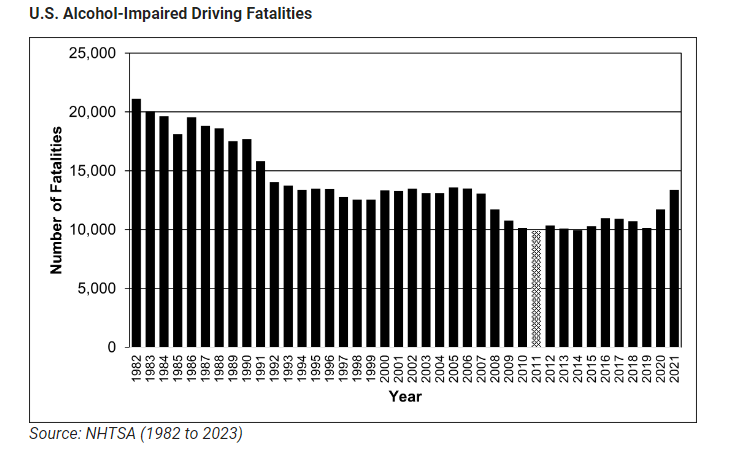In the late 1990s, a significant shift occurred in the fight against drunk driving across the United States. States began to lower the legal blood alcohol concentration (BAC) limit for a per se DUI from 0.10% to 0.08%. This change, championed by many as a necessary step towards safer roads, was expected to lead to a decrease in DUI-related fatalities. However, the years following the implementation of this lower limit have painted a more complex picture of its impact on road safety. George Creal, a seasoned DUI lawyer with extensive experience in defending those accused of DUI, delves into the unintended consequences of this well-intentioned policy change.
The Rationale Behind the Shift
The push to lower the legal BAC limit was driven by a straightforward premise: lower levels of alcohol consumption impair driving ability, and by setting stricter standards, potential offenders would be deterred from drinking and driving. Advocacy groups, along with federal incentives, propelled this initiative forward, leading to nationwide adoption by 2004.
The Unexpected Outcome
Contrary to expectations, studies and statistics in the years following the adoption of the 0.08% BAC limit have shown a nuanced impact on DUI-related fatalities. Some analyses have suggested that while there were reductions in certain states, nationally, the anticipated decline in fatalities did not materialize as expected. In some instances, data pointed towards an increase in DUI-related deaths, sparking a debate about the efficacy and unintended consequences of the policy change.
The federal legislation that changed the legal blood alcohol concentration (BAC) limit from 0.10 to 0.08 for DUI offenses was the Transportation Equity Act for the 21st Century (TEA-21), passed in 2000 and signed by President Bill Clinton. This act included a provision that coerced states to adopt the 0.08% BAC limit as the legal threshold for impaired driving. States were required to adopt the 0.08% BAC limit by 2004 to avoid a loss of federal highway funding.
In 2021 (the latest data available) there were 13,384 people killed in crashes involving alcohol-impaired drivers (defined as drivers or motorcycle riders with BACs of .08 g/dL or higher). This was an increase of 14.2% from the 11,718 fatalities in 2020 (National Center for Statistics and Analysis, 2023a). In 1999, the year before the legal limit was lowered nationally, DUI related fatalities totaled 15,786 and by 2004 when the last states had adopted the 0.08 legal limit, DUI fatalities had increased to 16,919 nationally. A 2021 study found that the ride-sharing platform Uber had reduced overall U.S. traffic fatalities by about 4% overall, and cut alcohol-related traffic deaths by over 6%. That represented about 494 fewer deaths in 2019 alone-about 214 fewer of them from drunk-driving, according to the study. Michael Anderson and Lucas W. Davis, Uber and Alcohol-Related Fatalities, NBER Working Paper No. 29071, July 2021. (https://www.nber.org/system/files/working_papers/w29071/w29071.pdf) Demonstrating the free market forces and innovation are more successful than government intervention at solving destructive behaviors than more punitive laws and law enforcement.
Examining the Causes
Several factors may contribute to the unexpected outcomes observed following the lowering of the legal BAC limit:
- Shift in Law Enforcement Focus: The new limit may have redirected law enforcement efforts towards drivers with BAC levels between 0.08% and 0.10%, who are statistically less likely to be involved in fatal accidents compared to those with higher BAC levels. This shift could potentially detract from efforts to apprehend drivers at higher levels of impairment who pose a greater risk. The average blood alcohol level in a DUI fatality is 0.17.
- Public Perception and Behavior: The change might have had a paradoxical effect on public behavior, with some drivers assuming that levels just below the legal limit are safe for driving, thereby not adjusting their drinking habits responsibly.
- Resource Allocation: The increased number of DUI arrests for lower BAC levels requires significant law enforcement and judicial resources, which might have been more effectively utilized in combating higher-level DUI offenses.
George Creal’s insights into the complexities surrounding DUI laws and their enforcement reflect his deep understanding of the legal system and his commitment to ensuring fair treatment for all individuals. As the debate continues on how best to reduce DUI-related fatalities, it’s clear that a multifaceted approach, informed by data and experience, will be essential.
Looking Ahead: Finding the Right Balance
The experiences following the reduction of the legal BAC limit underscore the complexity of addressing DUI-related fatalities. It suggests that while legal measures are crucial, they must be part of a broader strategy that includes education, rehabilitation, free market innovation solutions and targeted enforcement against high-risk behaviors.
As we move forward, George Creal advocates for a nuanced approach to DUI prevention, one that recognizes the multifaceted nature of drunk driving incidents and focuses on measures that have the most significant impact on reducing fatalities. This includes continuous evaluation of policies, investment in technology like ignition interlock devices, and programs that address the root causes of impaired driving.
In conclusion, while the intention behind lowering the BAC limit was to enhance road safety, the results highlight the importance of critically assessing the outcomes of such policies. By understanding the unintended consequences, lawmakers, law enforcement, and communities can better tailor their efforts to create safer roads for everyone



